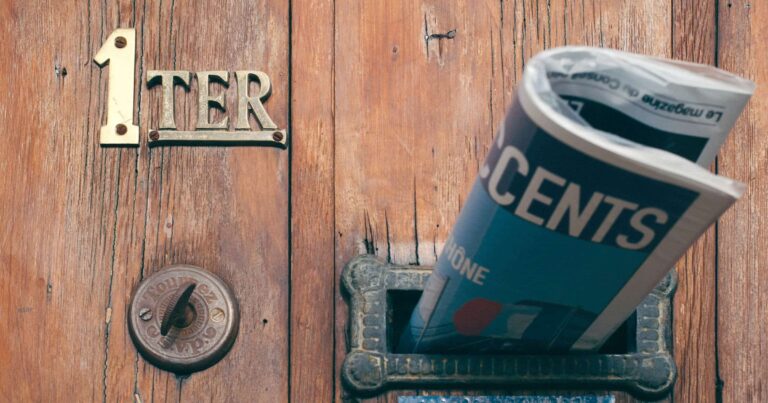Bring your newsletter identity to life with better messaging on About Us and signup pages.
A strong newsletter identity is how you align your goals with reader value. You spent time researching and strategizing your newsletter before it launched. You may have used a guide like the NPR Newsletter Identity plan, which is great! But now you need to take that plan publiTo to show readers the value you hope they will get, that means crafting effective messaging. Great messaging will have people dying to sign up and read.
If someone is seeing your website or newsletter signup page for the very first time, what do they see? How will they know you are unique and valuable? If you don’t show them, you won’t.
The best way to show value is with an emotional appeal. You want to make people feel something when they read about your newsletter. It could be joy, or it could be outrage. A hook is emotional. It makes readers feel seen.
You support your hook with specific statements showing how you’re different than other optins, and how you deliver on your promises. This is important: show, don’t tell.
Workshop your newsletter identity messaging with 3 simple questions
Developing a solid identity for your newsletter doesn’t need to be complicated. Answering these three simple questions is a great way to get started. If you answer these questions well, you’ll be ahead of most newsrooms:
- Who is your publication or newsletter for, and why should they care?
- What makes you better than other news sources?
- Why should readers trust you?
Clear, specific answers will do a better job of attracting the readers you want. This doesn’t mean you are excluding other readers. People have varied interests and motivations. People won’t always see you with 100% excitement. But a person who gets 60% excited is better than someone who completely disagrees with your editorial perspective.
We won’t concern ourselves with people who don’t fit our target audiences. You cannot be all things to all people. Those audiences are a distraction if other people find you and love you, great. Research to learn why; otherwise, focus on your target audiences.
Trying to be all things to all people won’t work
It’s scary shooting for a smaller audience. Will there be enough people? Will there be enough revenue to earn from a smaller group? There may not be! This is where people tend to get into trouble. They resort to generic statements that any newsroom can use.
You know the ones. Generic statements like these examples copied from newsroom websites:
- Dedicated to covering the issues that keep you informed.
- Our Reporting. Your Stories.
- News that matters
- Be Informed. Stay Connected.
- Hyperlocal news and information
None of these say anything to readers. There’s no hook in any of these. To to connect with readers — especially people who aren’t familiar with your work — we must be more specific. This is why audience research is crucial. We need to talk to people in a way that they will hear and want to hear more.
Trying to please everyone doesn’t work. We can’t boil the ocean. It’s easier to build several smaller audiences than trying to capture one colossal audience. So resist the urge to water down what makes you unique.
Comparing newsletter identity of 4 Baltimore publications
I reviewed about pages and newsletter signup pages for the breakdowns below. Why? Because newsletter identity is a part of the publication’s positioning, messaging, and brand. When your publication talks about itself, there should be a thread tying together internal beliefs and reader value.
Most people out there don’t know what you know from the inside. So if you want people to know something, you must tell them. If you want people to pay for journalism eventually, you have to tell them, repeatedly.
I grew up and started my career in Annapolis, about half an hour outside Baltimore City. There’s a mix of new and legacy newsrooms, which I think is excellent.
Let’s take a look at how four of these outlets choose to share their uniqueness and value with readers:
The Baltimore Sun
The Baltimore Sun’s motto used to be “Light for All.” I assume it still is, but I don’t see it on their website. On the About the Sun page, here’s what you get:
The Baltimore Sun, founded in 1837, is the largest daily newspaper in Maryland and owns the Capital Gazette and the Carroll County Times.
Our mission is to deliver the truth every day. We bring you the stories that matter most, written without bias, so you can make informed decisions.
The Sun’s Pulitzer Prize-winning journalism works to protect your interests, help navigate your daily life and tell the stories that connect you with the communities where you live and work.
We are headquartered in Baltimore, Maryland, and are part of the Tribune company portfolio.
https://www.baltimoresun.com/about/
The newsletter page is uninspired. I have no idea why they filed the first two newsletters under Sports.
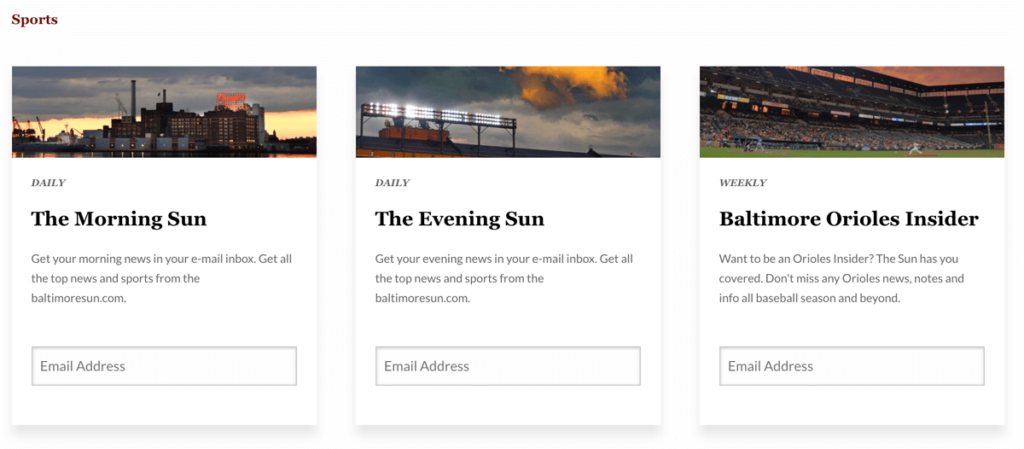
Image text:
The Morning Sun (Daily) – Get your morning news in your e-mail inbox. Get all the top news and sports from the baltimoresun.com
The Evening Sun (Daily) – Get your evening news in your e-mail inbox. Get all the top news and sports from the baltimoresun.com
Baltimore Orioles Insider (Weekly) – Want to be an Orioles Insider? The Sun has you covered. Don’t miss any Orioles news, notes and info all baseball season and beyond.
Let’s run the Baltimore Sun through our three key questions.
Who is The Baltimore Sun for, and why should I care?
This isn’t clear. They claim to “protect your interests” and “help navigate daily life,” but who is “you”? Everyone in Baltimore? It’s a city of 585,000 people in a metro area of 2.2 million. That’s a lot of different people with different interests. If I’m concerned about the ecological health of the Chesapeake Bay, do you protect my interests? How does that conflict with the interests of a paint factory polluting waterways? You can’t be on both sides.
What makes The Baltimore Sun better than other sources?
The Pulitzer Prizes mention is the only notable thing they have here. Saying you deliver “the truth every day” and “the stories that matter most” is lazy fluff without supporting statements.
Why should I trust The Baltimore Sun?
The awards give the Sun notoriety and social proof. I’m not a big fan of touting awards as a symbol of quality or trustworthiness. Many newsrooms have won awards, and outsiders don’t care as much. Pulitzers are an exception, given their notoriety. As you’ll see in some examples below, there are better ways to show trustworthiness.
How could this be improved?
My biggest problem with this page is that it reads like it was written for investors or other stakeholders rather than readers. It’s not for people looking to connect with their communities.
The Sun has a long history. Tapping into that history — the good, the bad, and the ugly — would position The Sun as a Baltimore institution with few rivals.
The Baltimore Banner
The Baltimore Banner uses the tagline “Nonprofit. Local news.” That’s a big fat meh. It’s not worth the pixels.
The Banner’s About Us page leads with a mission statement.
Our mission: To be an indispensable resource that strengthens, unites and inspires our Baltimore community. We will accomplish this through trustworthy, quality journalism that tells the varied stories of our people, delivers local news that readers are willing to support, and holds our leaders accountable. As a nonprofit founded by The Venetoulis Institute for Local Journalism , we are truly independent and we do not endorse leaders or political candidates.
Whether the news is happening downtown or in the surrounding counties, we’ve got it covered — because we believe that strong local news is essential to a strong community. And we’re committed to being a resource that locals trust to keep them informed about the world that’s closest to home.
https://www.thebaltimorebanner.com/about/
This one bums me out. The Banner has journalists and former colleagues I greatly respect, and their work deserves better than this.
Who is The Baltimore Banner for, and why should I care?
This page talks too much about itself. This page says more about the Banner than who the Banner is for. This mission statement is one reason I don’t care for website mission statements. I believe mission statements work better as internal documents for the organization to rally around or prioritize resources. They are meaningful inside the building; they aren’t meaningful outside the building.
Since the Banner wants to “inspire our Baltimore community,” let’s say The Baltimore Banner is for the Baltimore community. But that “our” doesn’t feel inclusive. Baltimore County surrounds Baltimore City, but the City isn’t in Baltimore County. They are two separate entities. So the Baltimore “community” feels like it avoids saying something directly.
The second paragraph mentions surrounding counties. This sounds like the Banner is for the metro area, not the City. That expands “our Baltimore community” to more than 2.8 million people. The suburbs and the City are quite different by design. Trying to cater to both is a significant initiative with historical challenges.
Why should I care? There’s a list of cliches here. Holding leaders accountable. Keeping people informed. Strong local news is essential to a strong community. But, without some specific supporting statements, these don’t mean much.
Why makes the Baltimore Banner better than other sources?
This question gets a good answer from the Banner. However, the Banner does not endorse leaders or political candidates. That is an essential distinction from legacy outlets. I’d like to see more, but this is something.
Whether you agree with this strategy or not is irrelevant. It will resonate with some readers and turn off others. It’s something to hook people who aren’t familiar with the Banner. It shows them that the Banner isn’t like every other news outlet.
Why should I trust the Baltimore Banner?
People generally appreciate nonprofits, so the Banner’s tax status should help earn some trust they might not otherwise get. But there’s plenty of room for improvement.
The Baltimore Banner newsletter signup page leaves much to be desired. The descriptions say little more than “we will email you some stuff.”
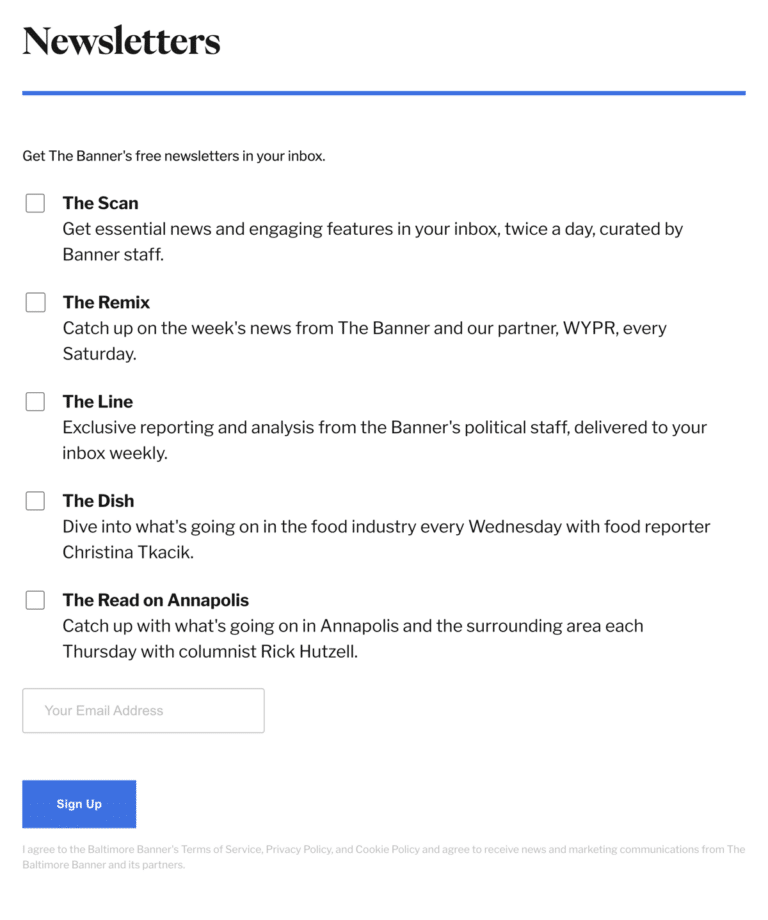
Image text: Get The Banner’s free newsletters in your inbox.
The Scan – Get essential news and engaging features in your inbox, twice a day, curated by Banner staff.
The Remix – Catch up on the week’s news from The Banner and our partner, WYPR, every Saturday.
The Line – Exclusive reporting and analysis from the Banner’s political staff, delivered to your inbox weekly.
The Dish – Dive into what’s going on in the food industry every Wednesday with food reporter Christina Tkacik.
The Read on Annapolis – Catch up with what’s going on in Annapolis and the surrounding area each Thursday with columnist Rick Hutzell.
Baltimore AFRO American
This a strong tagline: The Black Media Authority.
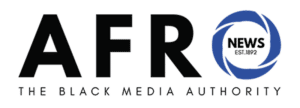
On the About Us page, the AFRO American tells a compelling history:
The AFRO knows what it’s like to endure challenging times. John H. Murphy, Sr., a former enslaved man founded the AFRO 130 years ago with $200 from his wife, Martha Howard Murphy. Together they created a platform to offer images and stories of hope to advance their community. The AFRO provides readers with good news about the Black community not otherwise found.
https://afro.com/about-us/
That’s a remarkable origin story. Right off the bat, the AFRO American sounds different from what we’ve seen.
Who is the Baltimore AFRO American for, and why should I care?
The AFRO American puts it front and center: It’s for Black Americans. Following a letter from their founder, the About Us page states: “The Afro-American has crusaded for racial equality and economic advancement for Black Americans for 130 years.” That’s an undeniable reason to care about what they are doing. It’s clear and easy to understand the value.
Why makes the Baltimore AFRO American better than other sources?
The first paragraphs highlight the AFRO American’s endurance. 130 years old. It’s led by 4th and 5th-generation descendants of the founders.
I like how the AFRO American shows you its mission and how it’s produced important work. Unfortunately, too many publications slap “Our Mission” above two paragraphs of corporate jargon written by a committee and call it a day.
Why should I trust the Baltimore AFRO American?
The AFRO American is the longest-running African-American family-owned newspaper in the U.S. Its history isn’t only long but storied. Former editor Carl Murphy used the power of the press to advocate for establishing state universities for African-Americans. Maryland currently has four.
The AFRO American publicly supported Paul Robeson and W.E.B. DuBois during the McCarthy era.
Notable journalists such as Langston Hughes, William Worthy, Lillian Johnson, and Nell Dodson all worked at the AFRO American. As a result, the AFRO American is a piece of living history. That’s hard to beat.
Contrast that with the Baltimore Sun, which mentions their Pulitzers but doesn’t mention its notable journalists like H.L. Mencken, Gwen Ifill, or David Simon.
The newsletter signup page touches on the AFRO American’s history without getting bogged down in too many details. Note two different pieces of social proof: “Join over 7,000+ other readers,” and “doing it right for over 129 years.”
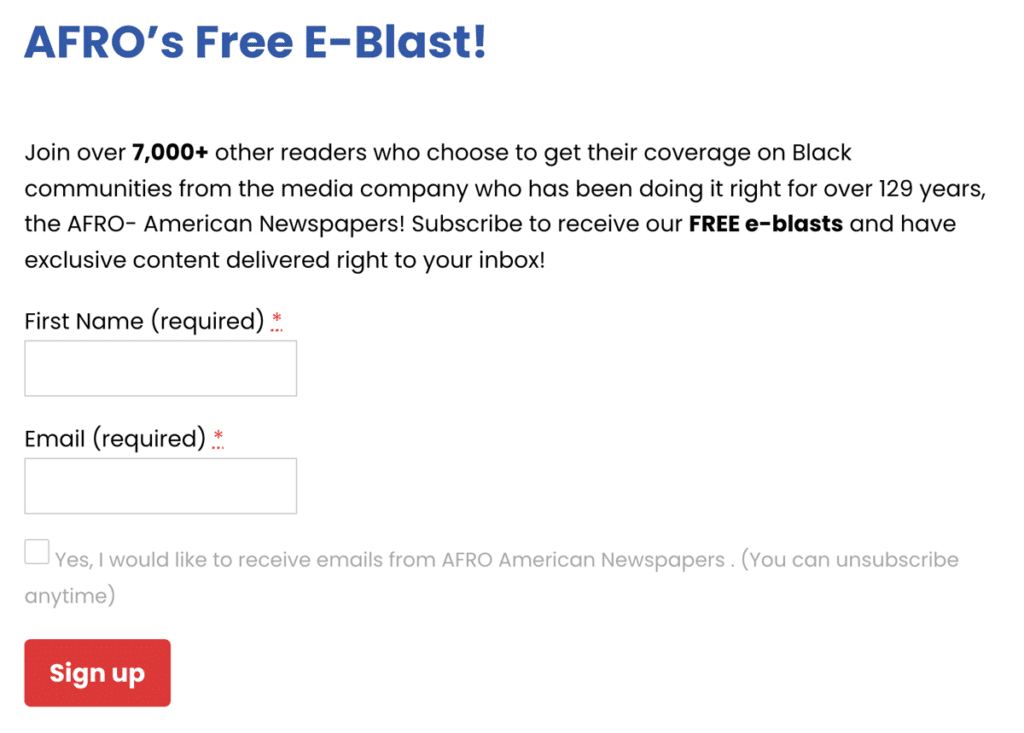
Image text: AFRO’s Free E-Blast!
Join over 7,000+ other readers who choose to get their coverage on Black communities from the media company who has been doing it right for over 129 years, the AFRO- American Newspapers! Subscribe to receive our FREE e-blasts and have exclusive content delivered right to your inbox!
Baltimore Beat
A challenge for recently launched newsrooms is you don’t have 100+ years of history and brand awareness to fall back on. The Baltimore Beat initially launched in 2017 but ceased operations in 2020. They re-launched in August 2022, only a few months after the Baltimore Banner.
The Beat’s About Us page includes a mission & values, which lay out some specific benefits the Beat provides.
Baltimore Beat is a Black-led, Black-controlled nonprofit newspaper and media outlet. Our mission is to honor the tradition of the Black press and the spirit of alt-weekly journalism with reporting that focuses on community, questions power structures, and prioritizes thoughtful engagement with our readers.
We aim to serve all of Baltimore City, including those with limited internet access and those who are a part of underrepresented communities.
Our organization aspires toward a more equitable, accountable, and rigorous future for journalism that fully represents the stories of all our neighbors.
https://baltimorebeat.com/about-us/
Who is Baltimore Beat for, and why should I care?
The very first sentence is a show stopper! The Beat is Black-led and Black-controlled. Jumping down to the Our Values section is a statement I love (emphasis theirs):
“We reflect the energy and excitement of the city, its legacy as a cultural hub of Black American life, and the joy of being a Baltimorean.”
This is a clear statement of who the Beat is publishing for. Readers who share this vision will not only care, and they will be excited to see more. This is a statement that attracts the people the Beat wants to attract.
Why makes Baltimore Beat better than other sources?
The Beat knocks this one out of the park. Let’s start with the 2nd and 3rd paragraphs of the mission:
We aim to serve all of Baltimore City, including those with limited internet access and those who are a part of underrepresented communities.
Our organization aspires toward a more equitable, accountable, and rigorous future for journalism that fully represents the stories of all our neighbors.
Legacy media outlets have a terrible track record on access and representation. The Beat shares their strategic decision for correcting this media behavior pattern:
We believe news should be free and accessible to all and that to achieve this, journalism cannot solely be digital and should not be paywalled.
You may disagree with these statements. That means they aren’t for you. Instead, they are for the audience the Beat wants to attract.
Why should I trust Baltimore Beat?
For starters, if you can’t afford other news sources, the Beat is the more accessible option. That sends a positive signal to people, especially those neglected or ignored.
In the Beat’s words (emphasis theirs): “We know that for news to work for everybody, it must first and foremost consider those who are underserved and afforded the least access.”
These are all ambitious goals, and I hope the Beat exceeds them. But, to a person who knows nothing of the Beat, these goals set expectations. This expectation is specific. It’s different from what people are used to seeing from The Baltimore Sun or local TV news.
I recommend you read the whole About Us page. It’s only a few hundred words, but it does a great job of establishing a strong identity. The Baltimore Beat doesn’t have a newsletter page as of this writing.
Get the next Q&A as soon as it drops +
real newsletter breakdowns, step-by-step guides and more
Outlier Media’s strong newsletter identity shines
Before you go any further, what do you know about Outlier Media?
It’s okay if you don’t. Outlier Media is based in Detroit. If you don’t live in Detroit, it’s reasonable not to be aware of them. Even if you live in Detroit, there’s nothing wrong with not knowing what you don’t know.
There are bigger newsrooms than Outlier in Detroit. There are newsrooms with more name recognition and bigger budgets. So Outlier must get space inside Detroiters’ minds.
Let’s look at what Outlier is up against.
- Detroit Free-Press. Founded in 1831, it’s the largest daily newspaper in Detroit.
- The Detroit News. Founded 1873. The other major daily in Detroit.
- WDET. Detroit’s NPR station, a community service of Wayne State University.
- Local TV News affiliates.
WDET is the only site of the legacy outlets with an About Us page. Unfortunately, it’s nothing exciting and highlights the NPR relationship before anything about Detroit.
As for newsletter signups, this is the bottom of the barrel.
The Free-Press Daily Briefing promises to “Start your day with the morning’s top news.” The Detroit News has the same description for their daily briefing. This isn’t surprising. The Free-Press and News are owned by Gannett and have a joint operating agreement.
WDET invites readers to “Stay connected to Detroit.”
A quick sample of local news stations shows newsletters that offer “your daily deep dive into important and interesting local topics!” and “all the news you need to know, every day.”
All boring filler. This is a great opportunity.
Now let’s take a look at Outlier Media.
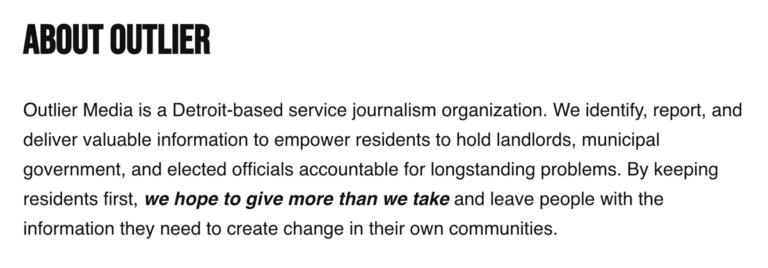
Image text: Outlier Media is a Detroit-based service journalism organization. We identify, report, and deliver valuable information to empower residents to hold landlords, municipal government, and elected officials accountable for longstanding problems. By keeping residents first, we hope to give more than we take and leave people with the information they need to create change in their own communities.
This is how to show you are better. Outlier isn’t “representing your interests” if you’re a shitty landlord. The priority is on residents, and Outlier aims to “give more than we take.” This offers collaboration and exchange rather than proclamation and extraction.
Who is Outlier Media for, and why should I care?
Outlier Media is for Detroit residents. It couldn’t be more clear. They aim to “empower residents,” they pledge to “keep residents first” and give people what they need to “create change in their own communities.” None of the other Detroit newsrooms are saying they will do this for potential readers.
Why makes Outlier Media better than other sources?
When you distinguish yourself from other options, that uniqueness makes you better in a reader’s eyes. A new reader leaves with the impression that this newsroom cares about me.
Outlier shines in this regard on their newsletter page. Each individual newsletter demonstrates its reader value in clear terms.
Detour Detroit has news and includes “Detroit’s vibrant culture and communities.”
The Dig focuses on housing and real estate. This is an excellent topic often covered with less inspection and insight than it deserves.
Detroit Documenters is people-powered news from the Documenters community. The Documenters program trains and pays people to report on public meetings that are often uncovered.
Why should I trust Outlier Media?
Following the team photos on the About Us Page, Outlier says, “we work to serve and learn alongside our news consumers in Detroit.” This collaborative approach is revolutionary to many people. But, unfortunately, the flawed objective journalism model disconnects journalists from their audiences. This has adverse effects and erodes trust.
Outlier sets a new example of collaboration. Putting it out there is a significant differentiator.
On the newsletters page, Outlier links some recent newsletters for people to read before subscribing. Does this mean someone could read all the newsletters without coughing up an email address? Sure. But Outlier is demonstrating trust for their readers first. They are offering something of value to the reader in exchange for their email address rather than the other way around. It’s a smart move because it expresses trust.
Don’t treat your messaging as “set it and forget it”
Getting messaging right takes some time to dial in. As you learn more about your audiences and your strategies change, you’ll also want to update your messaging and copy. The effort is worth it because you will grow and evolve with your readers rather than being slow to respond to new information. That’s an excellent ability for an adaptable newsroom to have.



